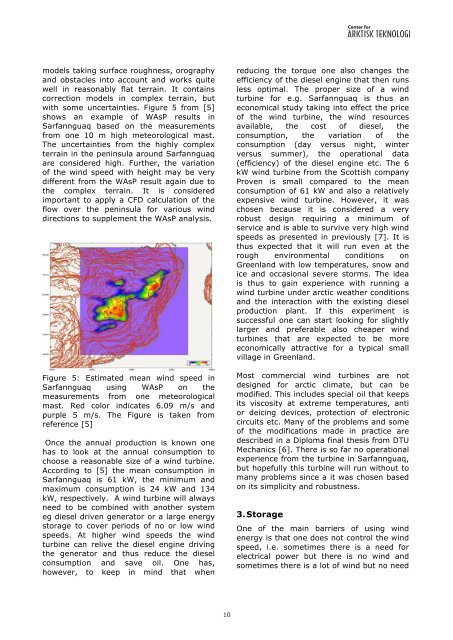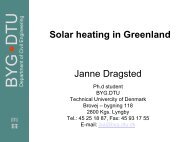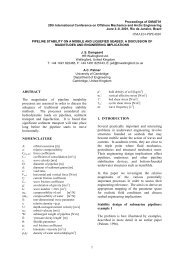Energiforsyning i Arktis – hvilken vej vælger Grønland? - Artek ...
Energiforsyning i Arktis – hvilken vej vælger Grønland? - Artek ...
Energiforsyning i Arktis – hvilken vej vælger Grønland? - Artek ...
You also want an ePaper? Increase the reach of your titles
YUMPU automatically turns print PDFs into web optimized ePapers that Google loves.
models taking surface roughness, orography<br />
and obstacles into account and works quite<br />
well in reasonably flat terrain. It contains<br />
correction models in complex terrain, but<br />
with some uncertainties. Figure 5 from [5]<br />
shows an example of WAsP results in<br />
Sarfannguaq based on the measurements<br />
from one 10 m high meteorological mast.<br />
The uncertainties from the highly complex<br />
terrain in the peninsula around Sarfannguaq<br />
are considered high. Further, the variation<br />
of the wind speed with height may be very<br />
different from the WAsP result again due to<br />
the complex terrain. It is considered<br />
important to apply a CFD calculation of the<br />
flow over the peninsula for various wind<br />
directions to supplement the WAsP analysis.<br />
Figure 5: Estimated mean wind speed in<br />
Sarfannguaq using WAsP on the<br />
measurements from one meteorological<br />
mast. Red color indicates 6.09 m/s and<br />
purple 5 m/s. The Figure is taken from<br />
reference [5]<br />
Once the annual production is known one<br />
has to look at the annual consumption to<br />
choose a reasonable size of a wind turbine.<br />
According to [5] the mean consumption in<br />
Sarfannguaq is 61 kW, the minimum and<br />
maximum consumption is 24 kW and 134<br />
kW, respectively. A wind turbine will always<br />
need to be combined with another system<br />
eg diesel driven generator or a large energy<br />
storage to cover periods of no or low wind<br />
speeds. At higher wind speeds the wind<br />
turbine can relive the diesel engine driving<br />
the generator and thus reduce the diesel<br />
consumption and save oil. One has,<br />
however, to keep in mind that when<br />
10<br />
reducing the torque one also changes the<br />
efficiency of the diesel engine that then runs<br />
less optimal. The proper size of a wind<br />
turbine for e.g. Sarfannguaq is thus an<br />
economical study taking into effect the price<br />
of the wind turbine, the wind resources<br />
available, the cost of diesel, the<br />
consumption, the variation of the<br />
consumption (day versus night, winter<br />
versus summer), the operational data<br />
(efficiency) of the diesel engine etc. The 6<br />
kW wind turbine from the Scottish company<br />
Proven is small compared to the mean<br />
consumption of 61 kW and also a relatively<br />
expensive wind turbine. However, it was<br />
chosen because it is considered a very<br />
robust design requiring a minimum of<br />
service and is able to survive very high wind<br />
speeds as presented in previously [7]. It is<br />
thus expected that it will run even at the<br />
rough environmental conditions on<br />
Greenland with low temperatures, snow and<br />
ice and occasional severe storms. The idea<br />
is thus to gain experience with running a<br />
wind turbine under arctic weather conditions<br />
and the interaction with the existing diesel<br />
production plant. If this experiment is<br />
successful one can start looking for slightly<br />
larger and preferable also cheaper wind<br />
turbines that are expected to be more<br />
economically attractive for a typical small<br />
village in Greenland.<br />
Most commercial wind turbines are not<br />
designed for arctic climate, but can be<br />
modified. This includes special oil that keeps<br />
its viscosity at extreme temperatures, anti<br />
or deicing devices, protection of electronic<br />
circuits etc. Many of the problems and some<br />
of the modifications made in practice are<br />
described in a Diploma final thesis from DTU<br />
Mechanics [6]. There is so far no operational<br />
experience from the turbine in Sarfannguaq,<br />
but hopefully this turbine will run without to<br />
many problems since a it was chosen based<br />
on its simplicity and robustness.<br />
3. Storage<br />
One of the main barriers of using wind<br />
energy is that one does not control the wind<br />
speed, i.e. sometimes there is a need for<br />
electrical power but there is no wind and<br />
sometimes there is a lot of wind but no need





